Niteye have recently released their first dedicated headlamp, the HA30. It uses their favoured interface, the magnetic control ring, and is based around the frequently used 3xAAA configuration for power.
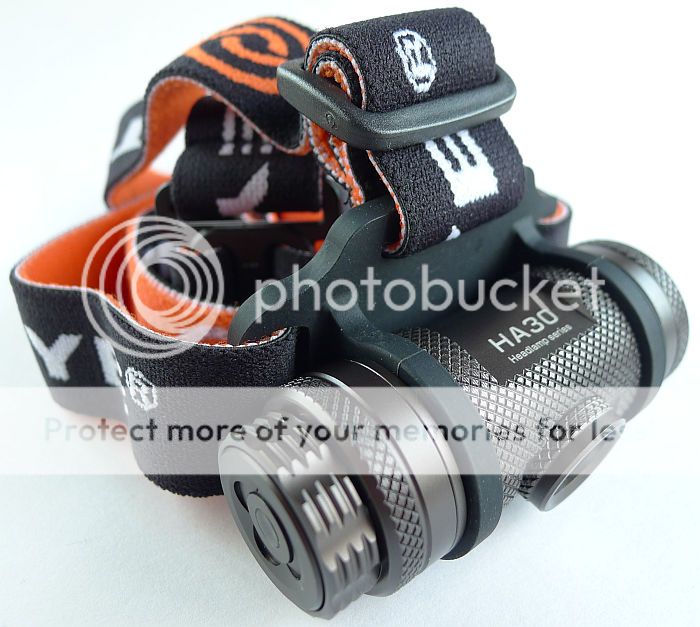
Initial Impressions:
This was a very intriguing review sample as it has undergone a few changes in its development. The box and documentation state it uses an XM-L emitter, but it actually has an XP-G2 LED. The design is familiar, yet different. It appears well thought out, keeping things simple yet functional.
I was glad to find the head-strap includes a top strap as this gives much better comfort and stability than just a brow strap.
The light unit itself is a surprisingly tactile, self-contained, metal canister with the emitter positioned halfway along the tube with very compact light head.
Fit and finish appears excellent on all components of this light.
What is in the box:
The HA30 arrives in a cardboard box with plastic window.
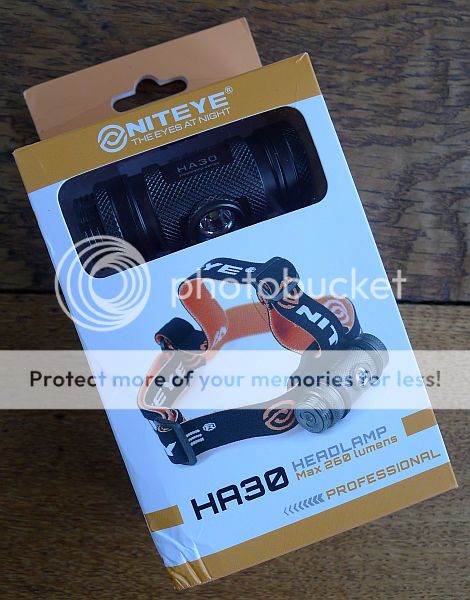
Included are the HA30, the head-strap (fully assembled), instructions, and a spare o-ring.
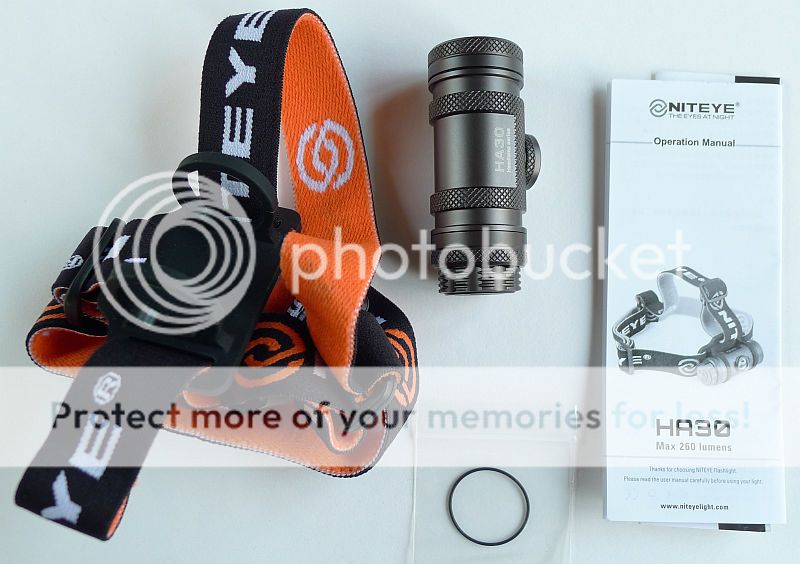
Taking a closer look and looking inside:
The HA30 out of the head-strap. You can see the grooves for the rubber bands of the head strap mount to sit in, and the magnetic control ring closest to you.
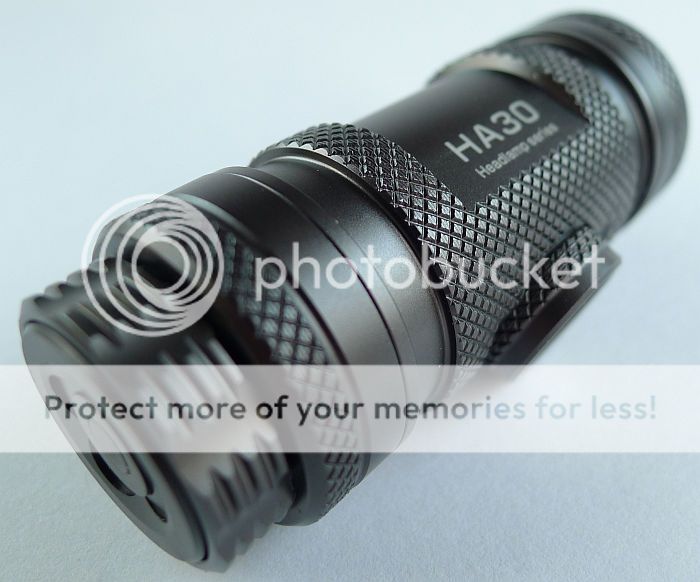
Scallops round the control ring provide a positive grip and there is a lot of stylistic detailing machined into the components. The clear window in the centre of the control ring is to view an indicator light.
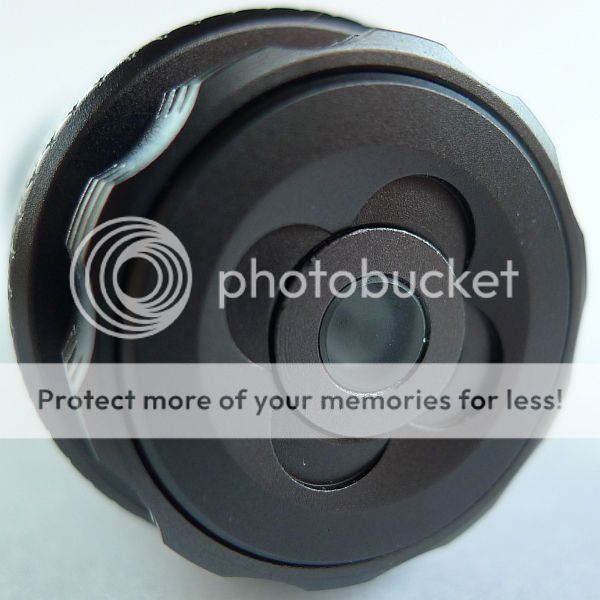
Looking directly into the small reflector housing, there is a flat glass lens and compact reflector with the XP-G2 LED
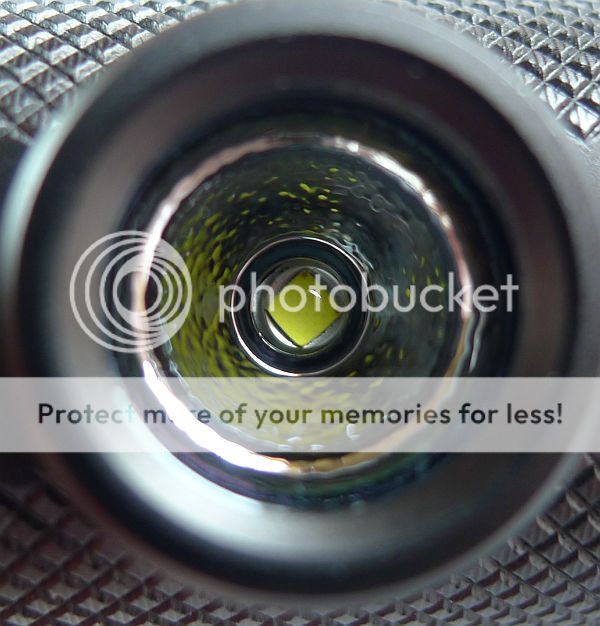
Opening up the HA30, by removing the end cap opposite to the control ring, reveals the oddly shaped battery tube. The use of a larger hole diameter on one side looks as if it might have been designed to take a single AA, or maybe a CR123 cell, however, after asking Niteye if this was the case I was told it only take 3xAAA.
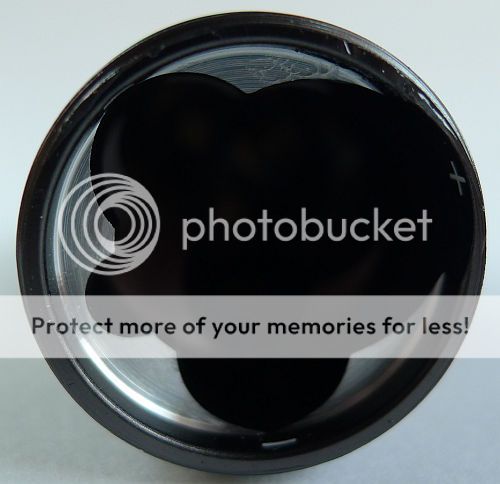
The end cap has a rotating contact board which has a locating pin which engages with a corresponding cut out in the body of the light.
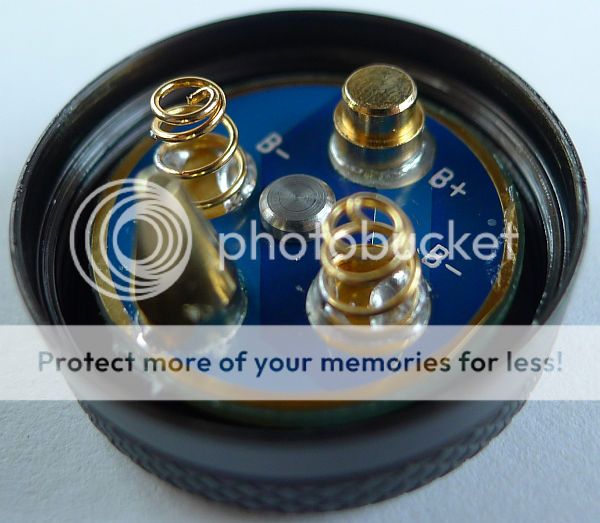
Inside the battery tube the matching set of terminals are located on a circuit board.
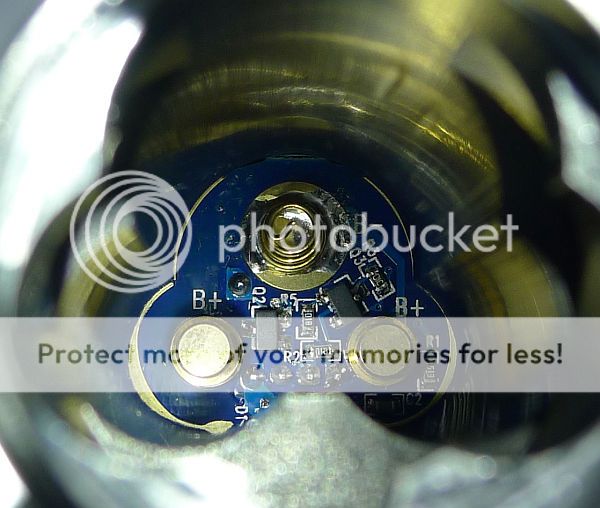
The threads a cleanly cut, well lubricated and near-trapezoid in form.
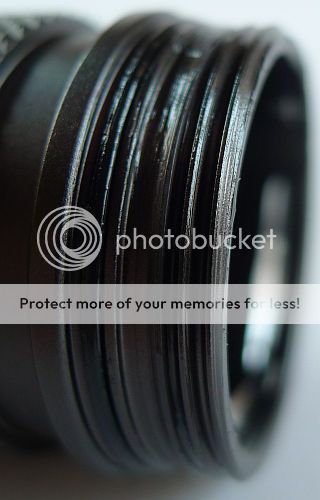
Battery polarity indicators are etched inside the battery tube, however the simplest indication is that a positive battery terminal is a solid metal post, and a negative terminal is a spring (which is a pretty universal standard).
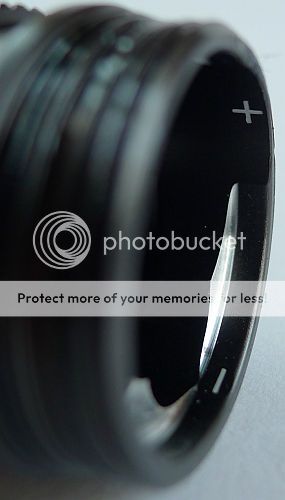
More detail of the control ring machining and quality of finish.
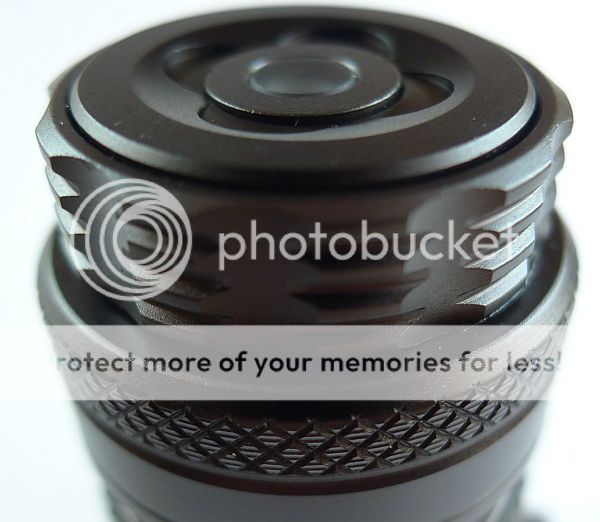
Modes and User Interface:
The HA30 has three modes, and only two of them are constant.
These are accessed by turning the control ring which has four positions. These are SOS, OFF, Low and High. There are click-stops for each of these positions.
Starting in the OFF position, rotating the control ring anti-clockwise (looking straight at it) activates the SOS output.
Again starting in the OFF position, rotating the control ring clockwise (looking straight at it) activates the Low output, and turning it further you get High.
As well as the control ring, there is an indicator light in the centre of the switch-end of the light. This shows a green light when the HA30 is on and the battery voltage is OK. When the battery voltage is low, this light turns red, but only when the HA30 is on.
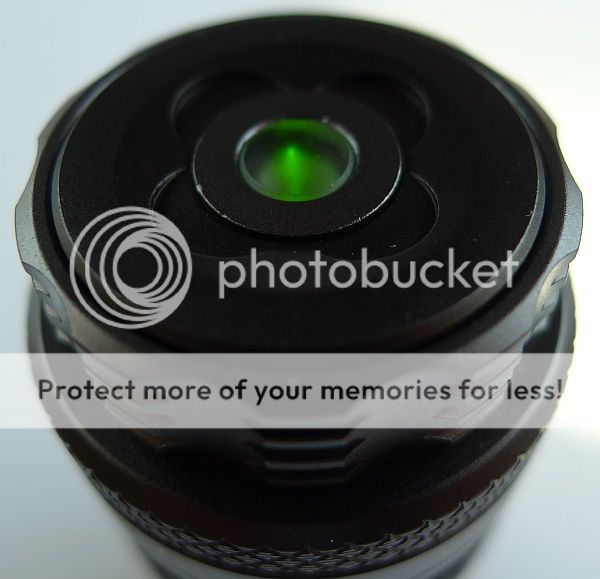
Batteries and output:
The HA30 runs on 3 x AAA batteries. Either Lithium AAAs (NOT li-ion), Alkaline AAAs, or Ni-Mh rechargeable AAAs can be used. Niteye themselves rated the HA30 using Ni-Mh
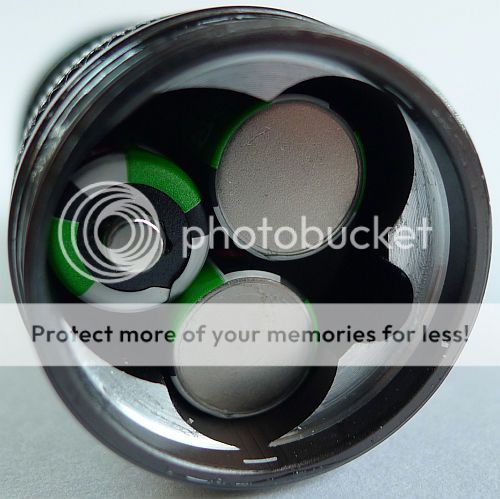
The testing was carried out with Ni-Mh cells.
To measure actual output, I built an integrating sphere. See here for more detail. The sensor registers visible light only (so Infra-Red and Ultra-Violet will not be measured).
Please note, all quoted lumen figures are from a DIY integrating sphere, and according to ANSI standards. Although every effort is made to give as accurate a result as possible, they should be taken as an estimate only. The results can be used to compare outputs in this review and others I have published.
There is PWM which is only noticeable on occasion. The High mode has a strange overlapping set of three frequencies of PWM (or at least that is how it appears on the oscilloscope).
As the HA30 utilises a magnetically controlled electronic switch, there is parasitic drain to consider.
The drain was measured at 171uA which is very good. The only slight issue is by using 3xAAA in series, due to AAA's low capacity, despite the low drain, the parasitic drain will fully deplete fresh batteries in 6 months. However due to the design of the end cap, it is easy to lock-out the HA30 with a half turn of the end cap and completely remove the drain. I found the best way to do this was to have the HA30 on Low and unscrew the end cap until the light went off, and then turn it a bit more to be sure.
The runtime graph shows a unusual increase in output during the first 10 minutes. With fresh batteries the ANSI output measures in at 237, but at 10 minutes into the output test this reaches 278lm. Most lights would be decreasing in output this far into the test, but the HA30's specification of 260lm output may be based on this figure instead.
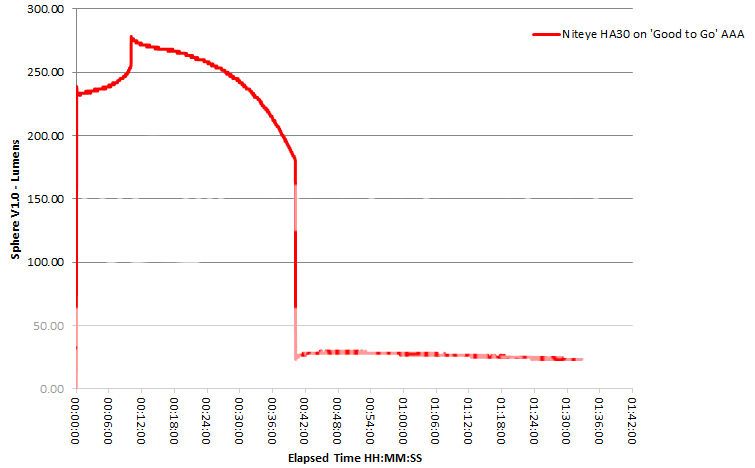
Once the output has dropped to the Low level output, this runs for several hours more with a gradually diminishing output.
In The Lab
NEW for Winter 2012 ANSI standards include maximum beam range. This is the distance at which the intensity of light from an emitter falls to 0.25lux (roughly the same as the lux from a full moon). This standard refers only to the peak beam range (a one dimensional quantity), so I am expanding on this and applying the same methodology across the entire width of the beam. From this data it is possible to plot a two-dimensional 'beam range profile' diagram which represents the shape of the illuminated area.
In order to accurately capture this information a test rig was constructed which allows a lux meter to be positioned 1m from the lens and a series of readings to be taken at various angles out from the centre line of the beam. As the rig defines a quadrant of a circle with a radius of 1m, all the readings are taken 1m from the lens, so measuring the true spherical light intensity. The rig was designed to minimise its influence on the readings with baffles added to shield the lux meter from possible reflections off the support members.
The distance of 1m was chosen as at this distance 1lux = 1 candela and the maximum beam range is then calculated as the SQRT(Candela/0.25) for each angle of emission.
In this plot, the calculated ANSI beam ranges are plotted as if viewed from above (for some lights there may also be a side view produced) using a CAD package to give the precise 'shape' of the beam.
For the HA30 we only need the 5m range grid. The HA30's beam profile shows a very wide spread of light with very broad hotspot.
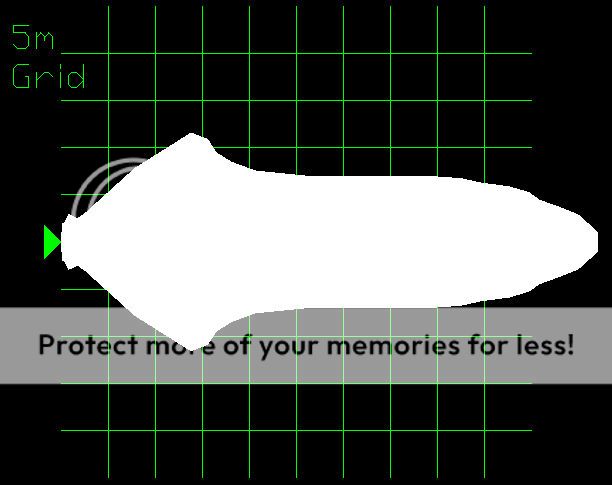
The beam
The indoor beamshot shows how wide and even the spill is with a soft hotspot. A really excellent beam for close range work, so ideally suited to its purpose.
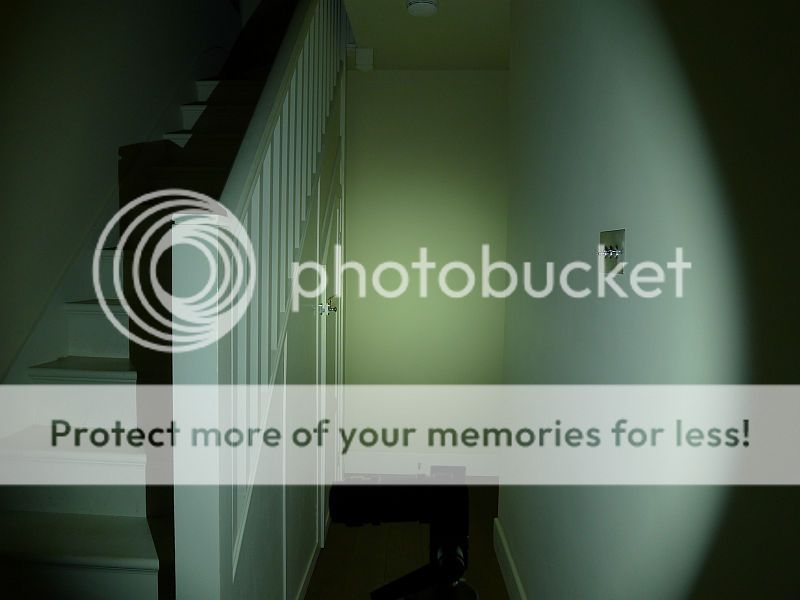
What it is really like to use…

Having found other headlamps that use a rubber mount similar to the HA30's to be very uncomfortable, I was pleasantly surprised to find the HA30 was very comfortable to wear for long periods. I suspect that this is particularly helped by the top strap, which makes the HA30 very stable without needing to be tight.
For me the inclusion of the SOS mode slightly spoils the HA30, the main reason being that from OFF, the control ring will rotate in one direction to Low and in the other to SOS. I found myself frequently activating SOS by mistake. If this mode had been removed and replaced with a third constant output mode with the control ring only rotating one direction from OFF and giving Moonlight, Low and High, it would be more intuitive to use.
So with only two constant output levels, is the HA30 too limited? I thought it would be, but have found that Low caters for most of what I need, with the High mode only being needed when going outdoors and wanting a little more range. It seems the two levels have been well chosen.
The battery indication light is a nice feature, but as this is a headlamp and the indication only shows when the light is on, in normal use it is not much help as you can't see it. It is more like 'I can't get high any more, why is that?'…'Oh the red light is showing, so the batteries are low'.
At the end of each time of using the HA30, I found myself locking out the end-cap to preserve the available power as this was very easy to do (if slightly unnecessary considering the low drain).
Adjusting the angle of the HA30 requires that it is rotated in the rubber mount. This was surprisingly stiff but easy enough to adjust. The advantage of this is that it will stay at the angle you set it. Being such a wide flood beam, the angle was not critical, and once I had adjusted it initially, never felt the need to change the angle for any of the different tasks I used it for.
The use of AAAs does mean the runtime on high is not that impressive, but they are an easily available standard cell, so there is no problem feeding the HA30. In real use, the Low output level works well in most instances you will find you don't need high that much anyway.
Every Niteye light I've used has had a really great beam, and the HA30 is no exception. The combination of very wide smooth spill, with a soft hotspot that give extra range without blinding you, works really well. In some ways the HA30 almost doesn't need anything other than the Low mode. The High mode gives you extra flexibility and at 278lm is impressively bright.
For excellent comfort, and a great beam, the HA30 is a good first step into the headlamp market for Niteye.
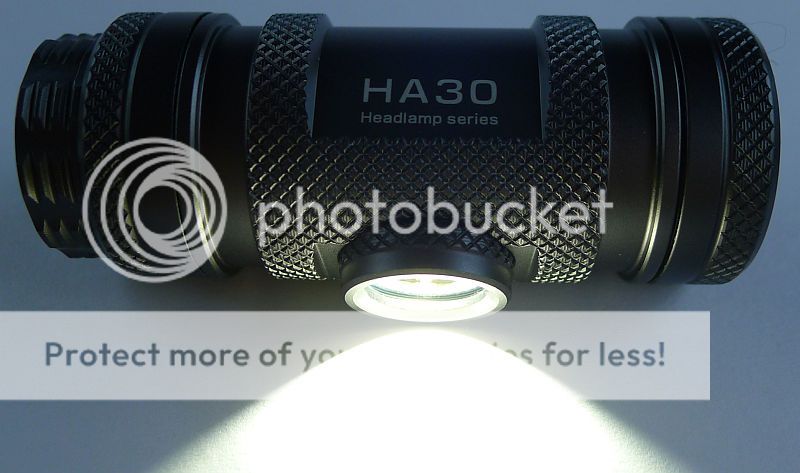
Test sample provided by Niteye for review.

Initial Impressions:
This was a very intriguing review sample as it has undergone a few changes in its development. The box and documentation state it uses an XM-L emitter, but it actually has an XP-G2 LED. The design is familiar, yet different. It appears well thought out, keeping things simple yet functional.
I was glad to find the head-strap includes a top strap as this gives much better comfort and stability than just a brow strap.
The light unit itself is a surprisingly tactile, self-contained, metal canister with the emitter positioned halfway along the tube with very compact light head.
Fit and finish appears excellent on all components of this light.
What is in the box:
The HA30 arrives in a cardboard box with plastic window.

Included are the HA30, the head-strap (fully assembled), instructions, and a spare o-ring.

Taking a closer look and looking inside:
The HA30 out of the head-strap. You can see the grooves for the rubber bands of the head strap mount to sit in, and the magnetic control ring closest to you.

Scallops round the control ring provide a positive grip and there is a lot of stylistic detailing machined into the components. The clear window in the centre of the control ring is to view an indicator light.

Looking directly into the small reflector housing, there is a flat glass lens and compact reflector with the XP-G2 LED

Opening up the HA30, by removing the end cap opposite to the control ring, reveals the oddly shaped battery tube. The use of a larger hole diameter on one side looks as if it might have been designed to take a single AA, or maybe a CR123 cell, however, after asking Niteye if this was the case I was told it only take 3xAAA.

The end cap has a rotating contact board which has a locating pin which engages with a corresponding cut out in the body of the light.

Inside the battery tube the matching set of terminals are located on a circuit board.

The threads a cleanly cut, well lubricated and near-trapezoid in form.

Battery polarity indicators are etched inside the battery tube, however the simplest indication is that a positive battery terminal is a solid metal post, and a negative terminal is a spring (which is a pretty universal standard).

More detail of the control ring machining and quality of finish.

Modes and User Interface:
The HA30 has three modes, and only two of them are constant.
These are accessed by turning the control ring which has four positions. These are SOS, OFF, Low and High. There are click-stops for each of these positions.
Starting in the OFF position, rotating the control ring anti-clockwise (looking straight at it) activates the SOS output.
Again starting in the OFF position, rotating the control ring clockwise (looking straight at it) activates the Low output, and turning it further you get High.
As well as the control ring, there is an indicator light in the centre of the switch-end of the light. This shows a green light when the HA30 is on and the battery voltage is OK. When the battery voltage is low, this light turns red, but only when the HA30 is on.

Batteries and output:
The HA30 runs on 3 x AAA batteries. Either Lithium AAAs (NOT li-ion), Alkaline AAAs, or Ni-Mh rechargeable AAAs can be used. Niteye themselves rated the HA30 using Ni-Mh

The testing was carried out with Ni-Mh cells.
To measure actual output, I built an integrating sphere. See here for more detail. The sensor registers visible light only (so Infra-Red and Ultra-Violet will not be measured).
Please note, all quoted lumen figures are from a DIY integrating sphere, and according to ANSI standards. Although every effort is made to give as accurate a result as possible, they should be taken as an estimate only. The results can be used to compare outputs in this review and others I have published.
| Niteye HA30 | I.S. measured ANSI output Lumens | PWM frequency (Hz) |
|---|---|---|
| High | 237 (note in the runtime test after 10 min this reaches 278lm) | 243>909>2000 overlayed |
| Low | 30 | 1000 |
There is PWM which is only noticeable on occasion. The High mode has a strange overlapping set of three frequencies of PWM (or at least that is how it appears on the oscilloscope).
As the HA30 utilises a magnetically controlled electronic switch, there is parasitic drain to consider.
The drain was measured at 171uA which is very good. The only slight issue is by using 3xAAA in series, due to AAA's low capacity, despite the low drain, the parasitic drain will fully deplete fresh batteries in 6 months. However due to the design of the end cap, it is easy to lock-out the HA30 with a half turn of the end cap and completely remove the drain. I found the best way to do this was to have the HA30 on Low and unscrew the end cap until the light went off, and then turn it a bit more to be sure.
The runtime graph shows a unusual increase in output during the first 10 minutes. With fresh batteries the ANSI output measures in at 237, but at 10 minutes into the output test this reaches 278lm. Most lights would be decreasing in output this far into the test, but the HA30's specification of 260lm output may be based on this figure instead.

Once the output has dropped to the Low level output, this runs for several hours more with a gradually diminishing output.
In The Lab
NEW for Winter 2012 ANSI standards include maximum beam range. This is the distance at which the intensity of light from an emitter falls to 0.25lux (roughly the same as the lux from a full moon). This standard refers only to the peak beam range (a one dimensional quantity), so I am expanding on this and applying the same methodology across the entire width of the beam. From this data it is possible to plot a two-dimensional 'beam range profile' diagram which represents the shape of the illuminated area.
In order to accurately capture this information a test rig was constructed which allows a lux meter to be positioned 1m from the lens and a series of readings to be taken at various angles out from the centre line of the beam. As the rig defines a quadrant of a circle with a radius of 1m, all the readings are taken 1m from the lens, so measuring the true spherical light intensity. The rig was designed to minimise its influence on the readings with baffles added to shield the lux meter from possible reflections off the support members.
The distance of 1m was chosen as at this distance 1lux = 1 candela and the maximum beam range is then calculated as the SQRT(Candela/0.25) for each angle of emission.
In this plot, the calculated ANSI beam ranges are plotted as if viewed from above (for some lights there may also be a side view produced) using a CAD package to give the precise 'shape' of the beam.
For the HA30 we only need the 5m range grid. The HA30's beam profile shows a very wide spread of light with very broad hotspot.

The beam
The indoor beamshot shows how wide and even the spill is with a soft hotspot. A really excellent beam for close range work, so ideally suited to its purpose.

What it is really like to use…

Having found other headlamps that use a rubber mount similar to the HA30's to be very uncomfortable, I was pleasantly surprised to find the HA30 was very comfortable to wear for long periods. I suspect that this is particularly helped by the top strap, which makes the HA30 very stable without needing to be tight.
For me the inclusion of the SOS mode slightly spoils the HA30, the main reason being that from OFF, the control ring will rotate in one direction to Low and in the other to SOS. I found myself frequently activating SOS by mistake. If this mode had been removed and replaced with a third constant output mode with the control ring only rotating one direction from OFF and giving Moonlight, Low and High, it would be more intuitive to use.
So with only two constant output levels, is the HA30 too limited? I thought it would be, but have found that Low caters for most of what I need, with the High mode only being needed when going outdoors and wanting a little more range. It seems the two levels have been well chosen.
The battery indication light is a nice feature, but as this is a headlamp and the indication only shows when the light is on, in normal use it is not much help as you can't see it. It is more like 'I can't get high any more, why is that?'…'Oh the red light is showing, so the batteries are low'.
At the end of each time of using the HA30, I found myself locking out the end-cap to preserve the available power as this was very easy to do (if slightly unnecessary considering the low drain).
Adjusting the angle of the HA30 requires that it is rotated in the rubber mount. This was surprisingly stiff but easy enough to adjust. The advantage of this is that it will stay at the angle you set it. Being such a wide flood beam, the angle was not critical, and once I had adjusted it initially, never felt the need to change the angle for any of the different tasks I used it for.
The use of AAAs does mean the runtime on high is not that impressive, but they are an easily available standard cell, so there is no problem feeding the HA30. In real use, the Low output level works well in most instances you will find you don't need high that much anyway.
Every Niteye light I've used has had a really great beam, and the HA30 is no exception. The combination of very wide smooth spill, with a soft hotspot that give extra range without blinding you, works really well. In some ways the HA30 almost doesn't need anything other than the Low mode. The High mode gives you extra flexibility and at 278lm is impressively bright.
For excellent comfort, and a great beam, the HA30 is a good first step into the headlamp market for Niteye.

Test sample provided by Niteye for review.

